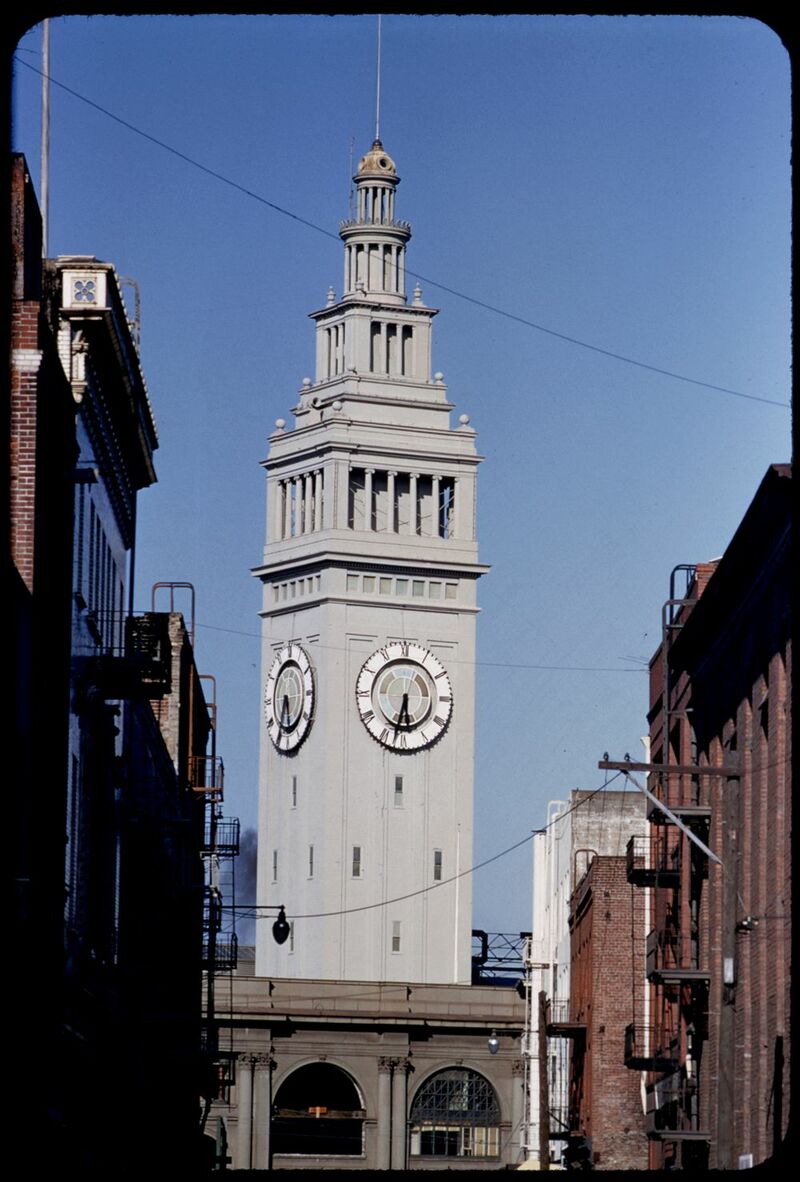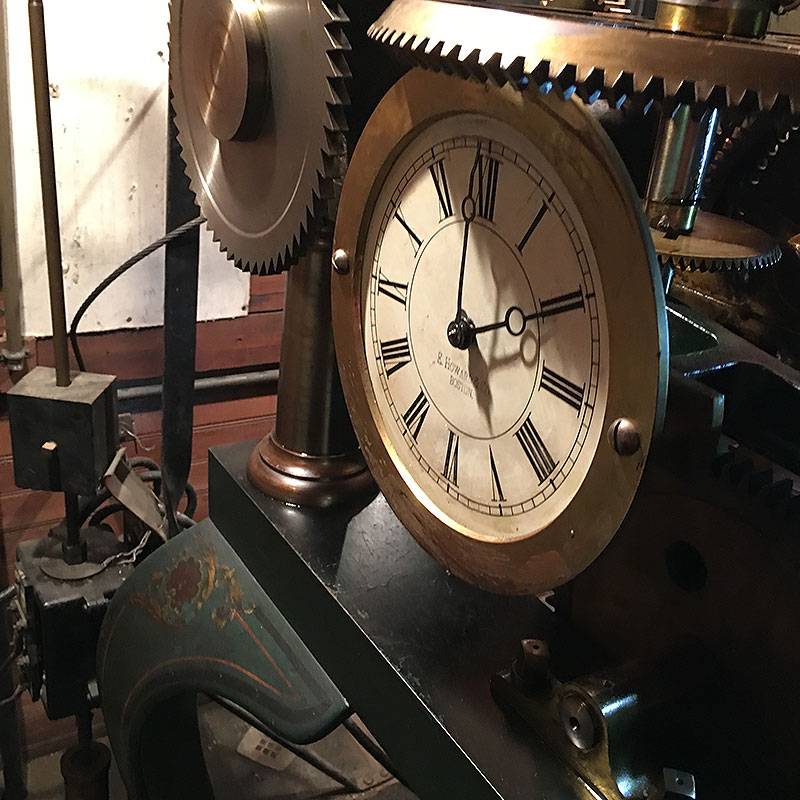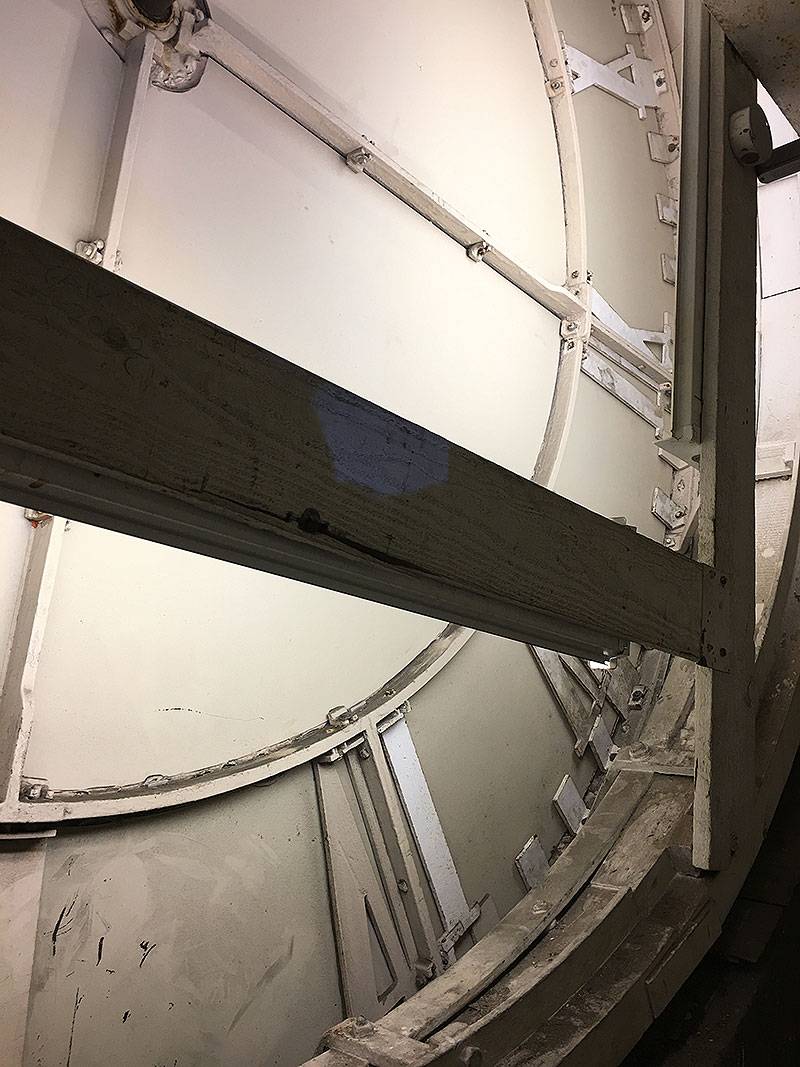Ferry Building Clock Springs Forward
Historical Essay
by Anne Evers Hitz
Ferry Building in 1955.
Photo: Charles Cushman
“If you want to join us, you need to be there at 1:15am sharp. We change the clock precisely at 2am,” said Paul. I thought, this is going to be interesting. I had just met Paul Bailey-Gates at History Days at the Old Mint. He had stopped by my table, which was piled high with copies of my book, San Francisco’s Ferry Building. While chatting, he mentioned that he goes up into the Ferry Building tower every spring to help Dorian Clair, who maintains the 1898 clock, adjust the time for Daylight Savings Time. Paul asked if I’d like to accompany them, and I leapt at the chance. He would have to get permission for me to go, and a few days later the chief engineer had given his OK. I was to meet him at the front lobby early, early Sunday morning on March 11.
I arrive, camera and notebook in hand, as scheduled. Dorian, Paul and I check in with security and sign the inevitable waivers. We took the elevator to the third floor, which is high-end office space and accessible to the public. Dorian gets out his keys, unlocks a door that reveals a steep staircase (the first of five) and I feel like I’ve stepped back 120 years.
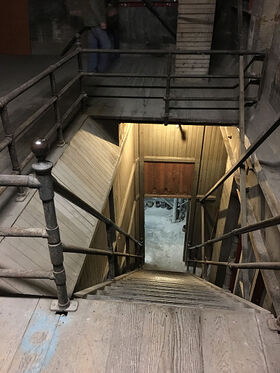
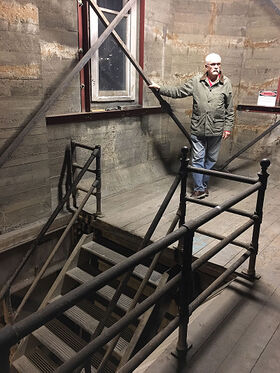
(left) The tower has five steep staircases (about 20 stairs each)
Photo: Anne Evers Hitz
(right) Dorian Clair at top of one flight of stairs.
Photo: Anne Evers Hitz
There are about 20 stairs in each flight, and one arrives on landings with wooden floors, thick with many years’ worth of dust. Some of the landings are used for storage, and people have written their names on the walls (I am invited to add mine, and I do, adding “3/10/18.” “Better write twenty eighteen,” Paul says).
Various items are scattered about—light fixtures, tools, boxes. We continue up, up, up—looking out dirty windows at the incredible night view of the Bay Bridge and the water. Big bolts that hold the clock faces stick out from the walls. Our goal is the clock movement on the ninth floor, but first we peer through wooden cabinets at the illuminated four clock faces on the same level as the movement.
The movement itself is a maze of brass and steel gears and wheels and cogs, all moving as the clock keeps time.
Photo: Anne Evers Hitz
The clock’s pendulum is enclosed in wooden housing (just below the movement). Farther up the tower we see the speakers for the carillon that chime on the hour and half hour. (They actually play a CD of Big Ben’s chimes, powered by a computer located near the Port Commission’s conference room on the second floor.)
Spring Forward
When we get to level nine, there’s a small raised wooden hut, an 8-foot cube that holds the actual clock, with its beautiful gears slowly turning. We still have some time before our 2am date with Daylight Savings, so we continue up more stairs.
The sirens, which set off an ear-splitting test warning on Tuesday at noon [note: currently on hiatus for upgrades], are on level 10. Going up even more, everything narrows, and one needs to climb up steel ladders into the dark cupola. We decide to pass on that as we need to get back to our clock duties. So back to level nine and the small hut.
The Ferry Building clock, one of the largest mechanical clocks in the world, is Boston clock maker E. Howard’s original Special #4, built in 1898. It’s now powered by a motor (First one was installed in 1974, and then Dorian installed another in 2000 when the clock was overhauled.) Dorian services it every four months. Before the motor was installed, a one-ton weight powered the clock. It dropped 48 feet in eight days, and had to be manually cranked back up.
Dorian Clair adjusting the time at 2am.
Photo: Anne Evers Hitz
Inside the hut, the clock movement sits on a platform with four curved green legs with faded painted flowers. At the base of one of the legs sits a forlorn-looking telephone that Dorian says was used to call to confirm the time. In this era of cell phones, that’s not necessary.
The movement itself is a maze of brass and steel gears and wheels and cogs, all moving as the clock keeps time. A gear at the top of the movement couples to four rods, each of which extends to one of the four clock faces.
Paul’s job is to pull out a setting pin that uncouples the clockworks from the gearing which turns the hands on the four dials. This enables Dorian to use a 3-foot steel bar (that he has hooked over the east-facing dial’s universal joint) to very slowly turn all four clock hands forward one hour. He says that he can feel if there’s wind resistance. Paul keeps an eye on the minute sockets buried with the locking plate so they know when the clock’s dials are set precisely. In the fall, when it’s time to move the clocks back an hour, Dorian reverses the electric motor for exactly one half hour. Paul and Dorian met through the San Francisco Chapter of the National Association of Watch and Clock Collectors, a vintage clock association. Dorian has been the proprietor of Antique Clock Repair in Noe Valley for over 30 years. He also services many other vintage clocks, including the 1901 clock at Stanford and the clock tower at the University of California at San Francisco clock on Parnassus Street.
Inside view of the Ferry building clock.
Photo: Anne Evers Hitz
The clock has been faithfully keeping time for many years, only stopping during the earthquakes of 1898, 1899, 1906 and 1989. Prior to the ’06 quake, the clock lost about two seconds a week. Otherwise it’s kept time just fine, helping keep ferry boat captains (and passengers) on schedule. The clock minute hands are 11 feet long, the clock faces are 22 feet in diameter, and its numerals are 3 feet high. One can see the time from about two miles up Market St., and the 235- foot tower can be seen from all over the City.
After Dorian and Paul finish their duties, Dorian locks up the hut and we start our steep descent down the many flights of stairs, and back out into the night. It was now officially after 3am, and street cleaners are out hosing the sidewalks in preparation for another busy day at the Ferry Building.
In this era of rapid technological change, one would think that you could just power up an app to change the time on the clock. Or maybe it’s a radio-controlled clock that automatically synchronizes with a signal from an atomic clock. But the process of changing the movement, itself a beautiful work of art, makes me glad that it’s still a manual process and the old clock just keeps doing its job for the City.
Anne Evers Hitz leads tours of the Ferry Building for City Guides. Her book, San Francisco’s Ferry Building, was published in August 2017.

